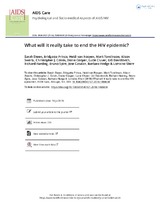What will it really take to end the HIV epidemic?
| dc.contributor.author | Skeen, Sarah | |
| dc.contributor.author | Prince, Bridgette | |
| dc.contributor.author | Cooper, Diane | |
| dc.date.accessioned | 2021-07-14T13:05:06Z | |
| dc.date.available | 2021-07-14T13:05:06Z | |
| dc.date.issued | 2018 | |
| dc.identifier.citation | Skeen, S. et al.(2018). What will it really take to end the HIV epidemic?. AIDS Care - Psychological and Socio-Medical Aspects of AIDS/HIV, 30, 1–4. https://doi.org/10.1080/09540121.2018.1488034 | en_US |
| dc.identifier.issn | 1360-0451 | |
| dc.identifier.uri | https://doi.org/10.1080/09540121.2018.1488034 | |
| dc.identifier.uri | http://hdl.handle.net/10566/6408 | |
| dc.description.abstract | Over the past two decades, key advances in the global HIV epidemic have shown that treatment is available, rollout is possible, and prevention is viable. We have witnessed how the impact of increased global investment, improved access to ART, advances in treatment and prevention science, activism, community engagement, and strategic action to target periods of vulnerability to transmission, have caused HIV-related deaths to begin to fall, life expectancy to increase, and decreased HIV new infection rates in some areas of the world (UNAIDS, 2018). However, most recently, in the face of this emerging success, global interest and investment in HIV has begun to decrease (Oberth & Whiteside, 2016). Programmatic traction is urgently needed if the current ambitious targets on HIV prevention, treatment and care are to be realised. | en_US |
| dc.language.iso | en | en_US |
| dc.publisher | Routledge | en_US |
| dc.subject | HIV | en_US |
| dc.subject | Disease services | en_US |
| dc.subject | Prevention | en_US |
| dc.subject | ART | en_US |
| dc.subject | Transmission | en_US |
| dc.title | What will it really take to end the HIV epidemic? | en_US |
| dc.type | Article | en_US |

